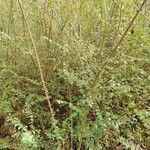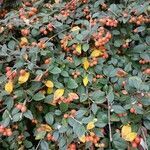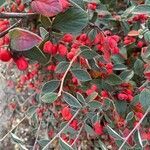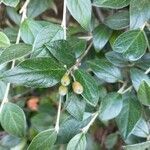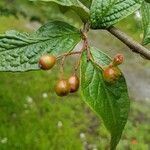Shrubs semievergreen, 1–3 m tall, with spreading, arching-inflexed branches. Branchlets dark grayish brown or grayish black, initially densely strigose, gradually glabrescent. Petiole 2–4 mm, tomentose; stipules linear-lanceolate, 2–4 mm, initially tomentose, glabrate; leaf blade elliptic to ovate, 2–3 × 1–1.5 cm, thick, lateral veins 4 or 5 pairs, raised abaxially and deeply impressed adaxially, abaxially densely yellow or white tomentose, adaxially initially appressed pubescent, glabrescent, base cuneate, apex acute or acuminate. Corymbs 1.5–2.5 cm, 5–11-flowered; rachis and pedicels densely tomentose; bracts linear, 2–3.5 mm, tomentose. Pedicel 2–4 mm. Flowers 6–7 mm in diam. Hypanthium campanulate, abaxially densely pubescent. Sepals triangular, 1–2 × 1.5–2.5 mm, apex acute or shortly acuminate. Petals erect, pink, broadly obovate or elliptic, 3–4 × 2–3 mm, adaxially puberulous near base, base shortly clawed, apex obtuse. Stamens 20, shorter than petals. Ovary pubescent apically; styles 2 or 3(–5), free, not exceeding stamens. Fruit orangish red or red, ovoid-globose, 6–7 mm in diam., initially pubescent, finally glabrous, pyrenes usually 3, rarely to 5. Fl. Jun–Jul, fr. Sep–Oct. 2n = 68*.
Evergreen shrub up to c. 3 m high; stems spreading and often somewhat arching; young shoots pale buff-tomentose, later becoming dark reddish brown. Lvs distributed along stems or in fascicles; petiole 2-4 mm long; blade elliptic to ovate, (15)-20-35-(45) × 7-18-(25) mm, subcoriaceous, acute and often short-mucronate, cuneate at base, ± shining and finely pilose with impressed veins above, usually with white to grey woolly tomentum (rarely pale buff) below, the tomentum persistent; margins slightly recurved and sometimes slightly sinuate; stipules ± linear-subulate, pilose. Fls (4)-7-15, in corymbs scattered along branches; peduncles short, tomentose. Sepals 1.5-2 mm long, ± triangular, buff-tomentose; apex sharply acute. Petals ± erect, 2.5-5 mm long, obovate, pinkish. Fr. ± ellipsoid, oblong-obovoid, obovoid, or subglobose, 5-9 mm long, scarlet or orange-scarlet.
Shrub, up to 6 m high. Branches arching; unarmed. Leaves simple, petiolate; elliptic, 20-30 mm long, apex acute, margins entire, upper surface hairy becoming glabrous and shiny, grey-green, lower surface densely white-tomentose; petioles 1-3 mm long. Flowers: corolla ± 10 mm in diameter, petals pink; Aug.-Jan. Fruit orange-red, subglobose pomes with three nutlets.
A shrub.
